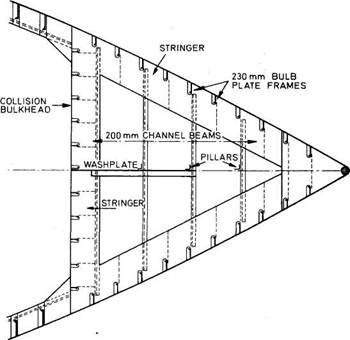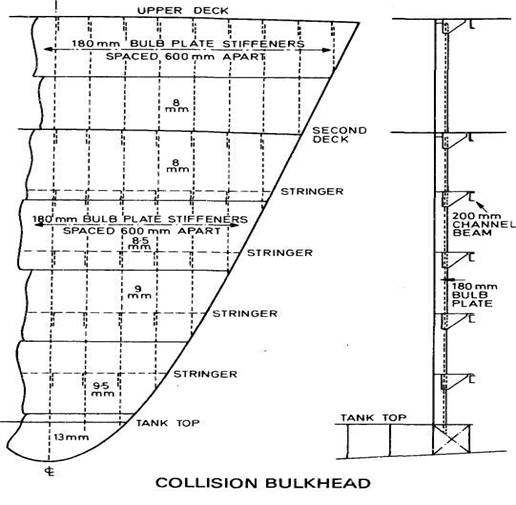QUESTION.
Sketch and describe a collosion
bulkhead

PANTING STRINGER Fig. a
In the fore peak, side stringers are fitted to the
shell at intervals of 2 m below the lowest deck (Fig. a). No edge stiffening is
required as long as the stringer is connected to the shell, a welded connection
being used in modern ships. The side stringers meet at the fore end, while in many
ships a horizontal stringer is fitted to the collision bulkhead in line with
each shell stringer. This forms a ring round the tank and supports the bulkhead
stiffeners. Channel beams are fitted at alternate frames in line with the
stringers, and connected to the frames by brackets. The intermediate frames are
bracketed to the stringer. The free edge of the bulkhead stringer may be
stiffened by one of the beams. In fine ships it is common practice to plate
over the beams, lightening holes being punched in the plate.
The tank top is not carried into the peak, but solid
floors are fitted at each frame.

Fig. shows the construction of a collision bulkhead.
These floors are slightly thicker than those in the
double bottom space and are flanged on their free edge. The side frames are
spaced 610 mm apart and, being so well supported, are much smaller than the
normal hold frames. The deck beams are supported by vertical angle pillars on
alternate frames, which are connected to the panting beams and lapped onto the
solid floors. A partial wash-plate is usually fitted to reduce the movement of
the water in the tank. Intercostal plates are fitted
for two or three frame spaces in line with the centre girder. The lower part of
the peak is usually filled with cement to ensure efficient drainage of the
space.
Between the collision bulkhead and 15% length from
forward the main frames, together with their attachment to the margin, are
increased in strength by 20%. In addition, the spacing of the frames from the
collision bulkhead to 20% of the length from forward must be 700 mm. Light side
stringers are fitted in the panting area in line with those in the peak. These
stringers consist of intercostal plates connected to
the shell and to a continuous face angle running along the toes of the frames.
These stringers may be dispensed with if the shell plating is increased in
thickness by 15%. This proves uneconomical when considering the weight but
reduces the obstructions to cargo stowage in the hold. The peak is usually used
as a tank and therefore such obstructions are of no importance.
The collision bulkhead is stiffened by vertical bulb
plates spaced about 600 mm apart inside the peak. It is usual to fit horizontal
plating because of the excessive taper on the plates which would occur with
vertical plating.
Fig. shows the construction of a collision bulkhead.
The structure in the after peak is similar in
principle to that in the fore peak, although the stringers and beams may be
fitted 2.5 m apart. The floors should extend above the stern tube or the frames
above the tube must be stiffened by flanged tie plates to reduce the
possibility of vibration.